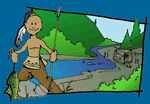


Geography and Landforms: Georgia is the largest state east of the Mississippi River and is 21st in size among the other states. The northernmost part of the state consists of broad valleys, rivers, and forested mountain ridges. These ridges are part of the southern section of the Appalachian Mountains. Georgia's highest point, Brasstown Bald Mountain (4,784 feet above sea level) is located here. The Piedmont section slopes gradually from this mountainous area down to the coastal plains. It is an area of rolling hills that contains several of the state's largest cities including Atlanta and Augusta. The "fall line" forms the southern boundary of this geographic area. Rivers flowing from the Piedmont to the neighboring Coastal Plain create "falls" or rapids along this line. The Atlantic Coastal Plain lies to the southeast of the Piedmont. The soil in this area is good for growing peanuts, sweet potatoes, and tobacco. The Okefenokee Swamp is in the southern part of this region. The East Gulf Coastal Plain is located southwest of the Piedmont. It is an area of rich farmland. |
 History:
The first European to enter the Georgia Region was Spanish explorer Hernando de Soto in 1540. A French colony was established a few years later, but this angered King Philip I of Spain. In 1565, the Spanish drove the French out. The Spanish later established several forts along the Atlantic Coast.
|
 Economy:
Agriculture makes up a large part of Georgia's economy. The state's most important crops are peanuts, corn, cotton, peaches, soybeans and tobacco. The vast pine forests in the northern part of the state provide much of the world's supply of resins and turpentine.
|
 First Inhabitants:
The Moundbuilders were the earliest inhabitants of what is now the state of Georgia. They were a group of Indians whose leaders lived in temples atop large earthen mounds. Their civilization was located in the northwest and southern portions of the state. The Moundbuilders occupied this area from 1000AD until approximately 1550AD when the first European settlers arrived.
|
Books Related To Georgia47 - Walter Mosley A Circle Unbroken - Sollace Hotze The Ever-After Bird - Ann Rinaldi Fame and Glory in Freedom, Georgia - Barbara O'Connor The Fantastic Secret of Owen Jester - Barbara O'Connor Freedom Train - Evelyn Coleman My Name is Sally Little Song - Brenda Woods Numbering All the Bones - Ann Rinaldi P is for Peach: A Georgia Alphabet - Carol Crane Peaches - Jodi Lynn Anderson Pink and Say - Patricia Polacco Shug - Jenny Han |
Famous Citizens:
|
| Capital: | Atlanta |
| Entered Union: | January 2, 1788 |
| Population: | 10,097,343 |
| Area | 59,425 |
| Bird | Brown Thrasher |
| Flower | Cherokee Rose |
| Nickname: | Peach State |
| Governor | Nathan Deal |
Places to Visit in Georgia: (Click the links to learn more.)
|




 Andersonville was one of the largest of the Confederate military prisons established during the Civil War. It was built early in 1864. More than 45,000 Union soldiers were confined here. Almost 13,000 men died from disease, malnutrition, overcrowding, or exposure to the elements. Today, it serves as a memorial to all American prisoners of war.
Andersonville was one of the largest of the Confederate military prisons established during the Civil War. It was built early in 1864. More than 45,000 Union soldiers were confined here. Almost 13,000 men died from disease, malnutrition, overcrowding, or exposure to the elements. Today, it serves as a memorial to all American prisoners of war.